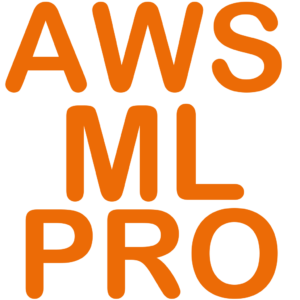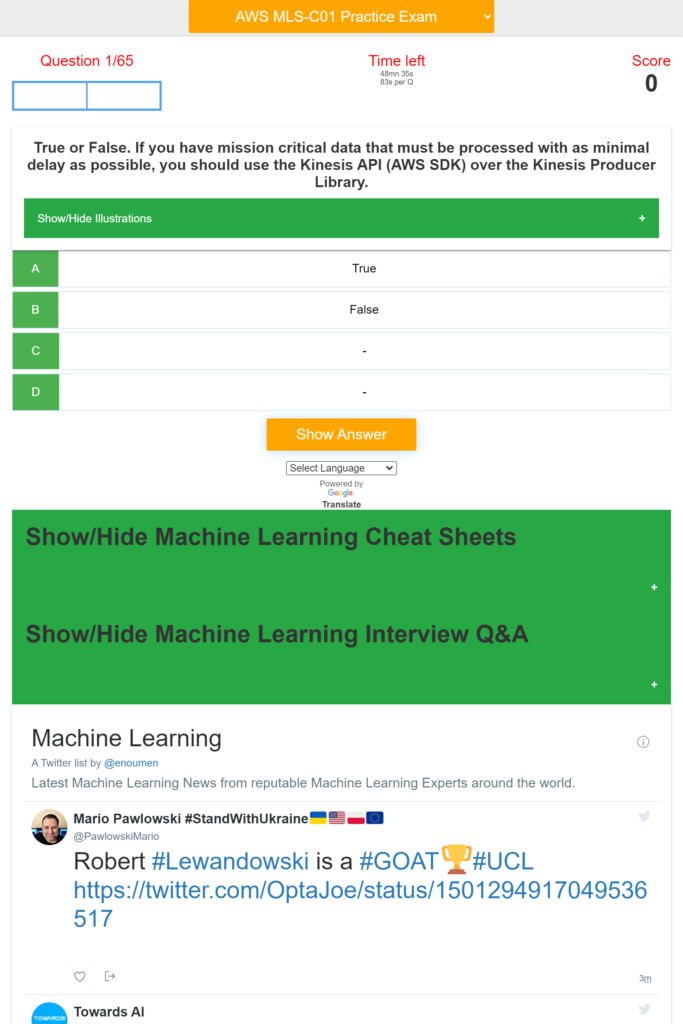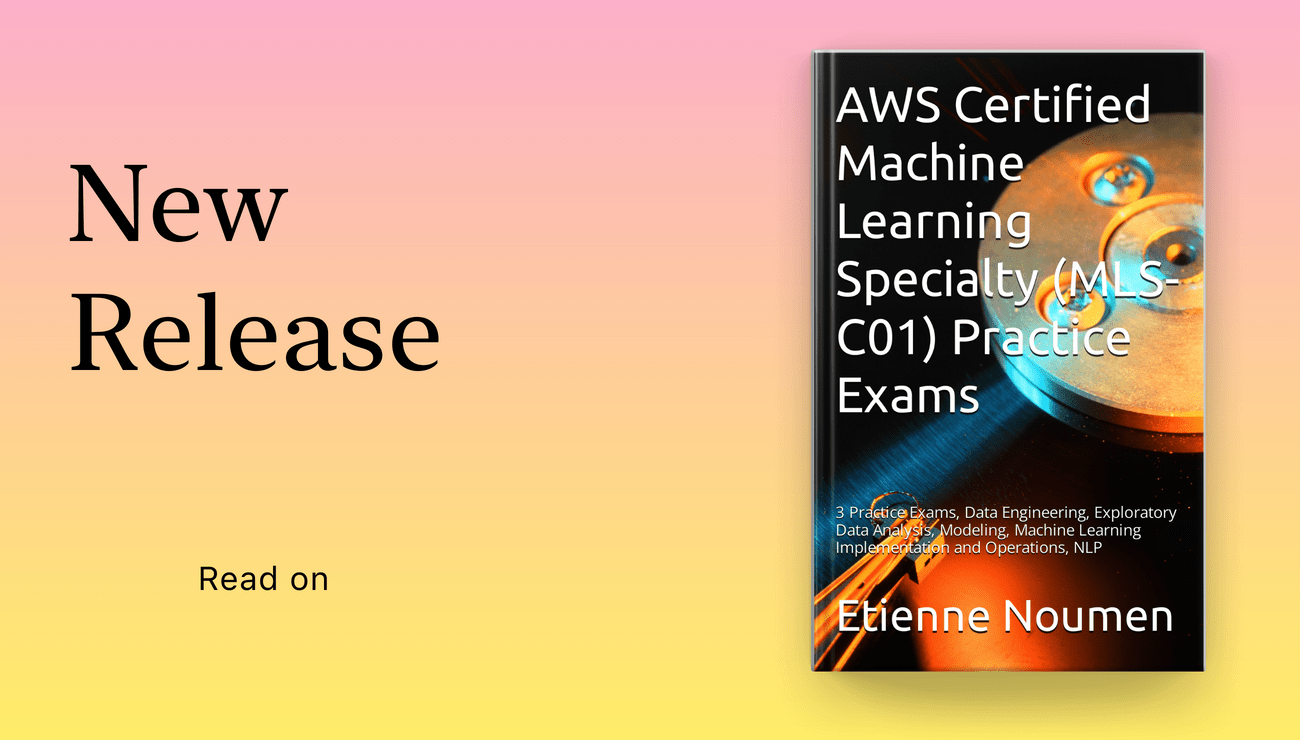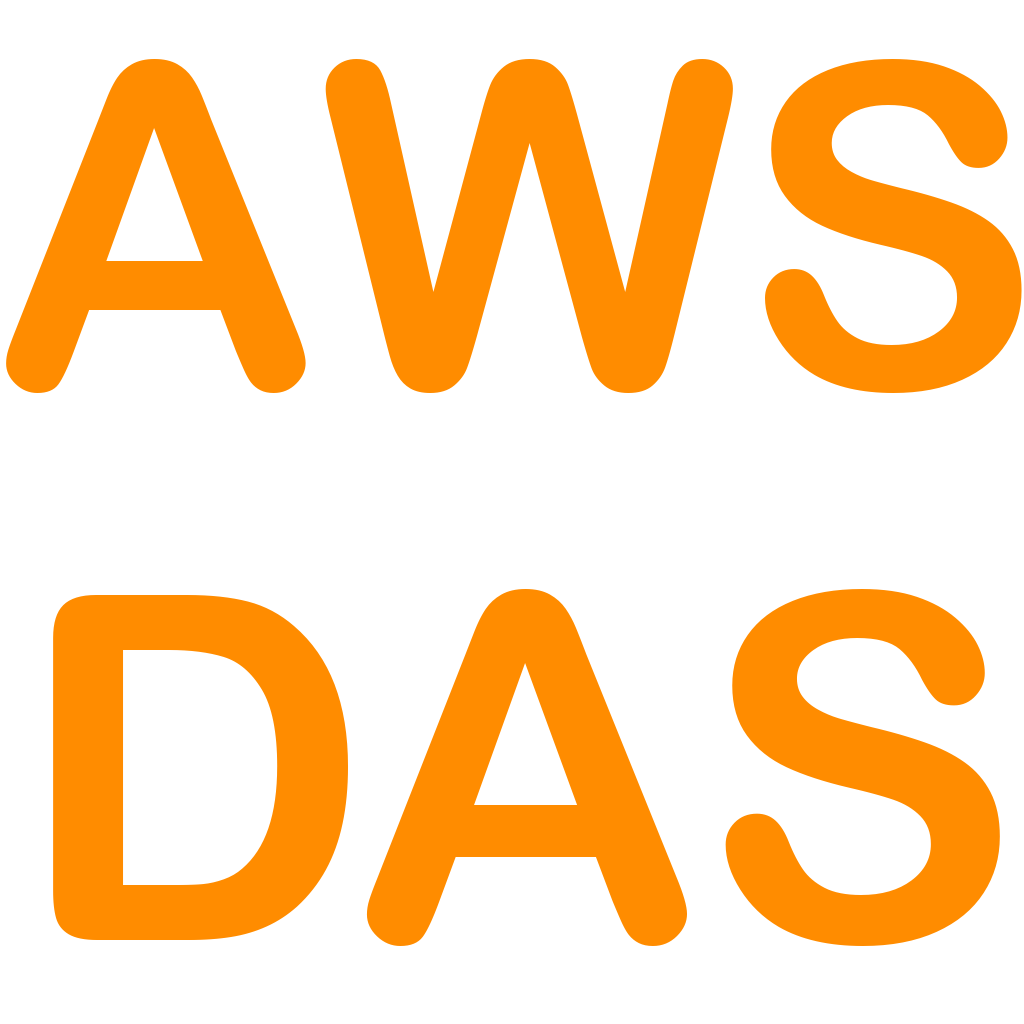You can translate the content of this page by selecting a language in the select box.
The AWS Certified Machine Learning Specialty validates expertise in building, training, tuning, and deploying machine learning (ML) models on AWS.
Use this App to learn about Machine Learning on AWS and prepare for the AWS Machine Learning Specialty Certification MLS-C01.
Download AWS machine Learning Specialty Exam Prep App on iOs
Download AWS Machine Learning Specialty Exam Prep App on Android/Web/Amazon
[appbox appstore 1611045854-iphone screenshots]
[appbox microsoftstore 9n8rl80hvm4t-mobile screenshots]

Download AWS machine Learning Specialty Exam Prep App on iOs
Download AWS Machine Learning Specialty Exam Prep App on Android/Web/Amazon
The App provides hundreds of quizzes and practice exam about:
– Machine Learning Operation on AWS
– Modelling
– Data Engineering
– Computer Vision,
– Exploratory Data Analysis,
– ML implementation & Operations
– Machine Learning Basics Questions and Answers
– Machine Learning Advanced Questions and Answers
– Scorecard
– Countdown timer
– Machine Learning Cheat Sheets
– Machine Learning Interview Questions and Answers
– Machine Learning Latest News
The App covers Machine Learning Basics and Advanced topics including: NLP, Computer Vision, Python, linear regression, logistic regression, Sampling, dataset, statistical interaction, selection bias, non-Gaussian distribution, bias-variance trade-off, Normal Distribution, correlation and covariance, Point Estimates and Confidence Interval, A/B Testing, p-value, statistical power of sensitivity, over-fitting and under-fitting, regularization, Law of Large Numbers, Confounding Variables, Survivorship Bias, univariate, bivariate and multivariate, Resampling, ROC curve, TF/IDF vectorization, Cluster Sampling, etc.
Domain 1: Data Engineering
Create data repositories for machine learning.
Identify data sources (e.g., content and location, primary sources such as user data)
Determine storage mediums (e.g., DB, Data Lake, S3, EFS, EBS)
Identify and implement a data ingestion solution.
Data job styles/types (batch load, streaming)
Data ingestion pipelines (Batch-based ML workloads and streaming-based ML workloads), etc.
Domain 2: Exploratory Data Analysis
Sanitize and prepare data for modeling.
Perform feature engineering.
Analyze and visualize data for machine learning.
Domain 3: Modeling
Frame business problems as machine learning problems.
Select the appropriate model(s) for a given machine learning problem.
Train machine learning models.
Perform hyperparameter optimization.
Evaluate machine learning models.
Domain 4: Machine Learning Implementation and Operations
Build machine learning solutions for performance, availability, scalability, resiliency, and fault
tolerance.
Recommend and implement the appropriate machine learning services and features for a given
problem.
Apply basic AWS security practices to machine learning solutions.
Deploy and operationalize machine learning solutions.
Machine Learning Services covered:
Amazon Comprehend
AWS Deep Learning AMIs (DLAMI)
AWS DeepLens
Amazon Forecast
Amazon Fraud Detector
Amazon Lex
Amazon Polly
Amazon Rekognition
Amazon SageMaker
Amazon Textract
Amazon Transcribe
Amazon Translate
Other Services and topics covered are:
Ingestion/Collection
Processing/ETL
Data analysis/visualization
Model training
Model deployment/inference
Operational
AWS ML application services
Language relevant to ML (for example, Python, Java, Scala, R, SQL)
Notebooks and integrated development environments (IDEs),
S3, SageMaker, Kinesis, Lake Formation, Athena, Kibana, Redshift, Textract, EMR, Glue, SageMaker, CSV, JSON, IMG, parquet or databases, Amazon Athena
Amazon EC2, Amazon Elastic Container Registry (Amazon ECR), Amazon Elastic Container Service, Amazon Elastic Kubernetes Service , Amazon Redshift
Important: To succeed with the real exam, do not memorize the answers in this app. It is very important that you understand why a question is right or wrong and the concepts behind it by carefully reading the reference documents in the answers.
Note and disclaimer: We are not affiliated with Microsoft or Azure or Google or Amazon. The questions are put together based on the certification study guide and materials available online. The questions in this app should help you pass the exam but it is not guaranteed. We are not responsible for any exam you did not pass.

Download AWS machine Learning Specialty Exam Prep App on iOs
Download AWS Machine Learning Specialty Exam Prep App on Android/Web/Amazon
- [D] Looking for adviseby /u/Separate_Molasses_73 (Machine Learning) on April 24, 2024 at 6:44 am
so i have multiple pricing table, and wish to compare which pricing are the cheapest, each pricing table has their own variables, so the way i decided to compare it is by making all of their variable equal in value, however another problems appears, which is if i change variable value, how does it affect the pricing? i'm thinking of using ML for this, but none unsupervised technique seems to fit this task, anybody has idea on how to tackle this? another approach that i try is using a regression like algorithm to make best fitted line, but that doesnt seems to work well submitted by /u/Separate_Molasses_73 [link] [comments]
- Personal Project [P]by /u/happyplantt (Machine Learning) on April 24, 2024 at 6:32 am
I’m graduating in 3 weeks, I am thinking of this random thing to showcase on my GitHub. My idea is to implement remote gas stations (Like a fuel truck). The plan is to get the traffic dataset of an area and analyze the data for all days of the week. Create a heatmap and then plot the existing gas stations on the map. Now the goal is to select top 5 places where there is traffic and less gas stations. (Assuming gas stations are required at high traffic flow areas). I’m not sure where to start, I mean where can I get the datasets other than kaggle. And also can someone help me to brainstorm the things I need to focus on. Thanks submitted by /u/happyplantt [link] [comments]
- [D] Transkribus vs Tesseract for Handwritten Text Recognition (HTR)by /u/Pretty_Instance4483 (Machine Learning) on April 24, 2024 at 6:15 am
I am looking for a HTR tool with the best accuracy and preferably not pricy (obviously). From my research, it seems that Transkribus was the most mentioned platform with good reviews. As I would need to convert images to text regularly I would need to pay the subscription. So I am wondering if I could use the Tesseract and/or TensorFlow Python library to achieve the same result for free. Would using Tesseract/TensorFlow be less accurate rather than using Transkribus? I learned only the basics of Machine Learning (TensorFlow, scikit-learn, keras), so I might have not enough knowledge to see the difference between the two solutions. Or is training Tesseract/TensorFlow would be challenging? submitted by /u/Pretty_Instance4483 [link] [comments]
- [D] How researcher think of inductive bias when thinking of creating new/improving foundational models?by /u/binny_sarita (Machine Learning) on April 24, 2024 at 2:36 am
I am undergradute student learning machine learning. What I got to know while reading few papers that we try to reduce search space by imposing inductive bias in machine learning models. And the success in creating useful models comes when inductive bias matches with the underlying data. In heriarchical models like NVAE how they instilled inductive bias by specifing the way data gets computed? (I thinks it's called algorithmic bias, not sure though) But how people think such inductive bias will be helpful, what is step by step procedure they go through to insist such inductive bias. I took a lot of class in machine learning and statistics but didn't got any lectures explaing such stuff. Did I missed any course/lecture? Please provide my with papers/lectures/talks related to it if possible Thankyou submitted by /u/binny_sarita [link] [comments]
- [R] Generalized Contrastive Learning for Multi-Modal Retrieval and Rankingby /u/Jesse_marqo (Machine Learning) on April 23, 2024 at 11:07 pm
Generalization of the popular training method of CLIP to be better suited for search and recommendations. Paper: https://arxiv.org/pdf/2404.08535.pdf Github: https://github.com/marqo-ai/GCL Generalises CLIP: Use any number of text and/or images to represent documents. Better text understanding by having both inter- and intra-modal losses. Can encode rank/importance/relevance, a.k.a “rank-tune”. Works with pretrained, text, CLIP models. Can learn uni- or multi-vector representations for documents. Works with binary and Matryoshka methods. Open source 10M row multi-modal dataset with 100k queries and ~5M products. Why? The prevailing methods for training embedding models are largely disconnected from the end use-case (like search), the vector database, the requirements of users, and a lack of representative datasets for development and evaluation, particularly when multiple modalities and ranking is involved. Limitations of current embedding models for vector search Although vector search is very powerful and enables searching across just about any data, the current methods have some limitations. The prevailing methods for training embedding models are largely disconnected from the end use-case (like search), the vector database, and the requirements of users. This means that a lot of the potential of vector search is being unmet. Some of the current challenges are described below. Restricted to using a single piece of information to represent a document Current models encode and represent one piece of information with one vector. The reality is that often there are multiple pieces of pertinent information for a document that may span multiple modalities. For example, in product search there may be a title, description, reviews, and multiple images, each with its own caption. GCL generalises embedding model training to use as many pieces of information as is desired. No notion of rank when dealing with degenerate queries When there are degenerate queries - multiple results that satisfy some criteria of relevance - the ordering of the results is only ever learned indirectly from the many binary relationships. In reality, the ordering of results matters, even for first stage retrieval. GCL allows for the magnitude of query-document specific relevance to be encoded in the embeddings and improves ranking of candidate documents. Poor text understanding when using CLIP like methods For multi-modal models like CLIP, these are trained to only work from image to text (and vice versa). The text-text understanding is not as good as text only models due to the text-text relationships being learned indirectly through images. For many applications, having both inter- and intra-modality understanding is required. GCL allows for any combination of inter- and intra-modal understanding by directly optimizing for this. Lack of representative datasets to develop methods for vector search In developing GCL, it became apparent there was a disconnect with publicly available datasets for embedding model training and evaluation for real-world use cases. Existing benchmarks are typically text only or inter-modal only and focus on the 1-1 query-result paradigm. Additionally, existing datasets have limited notions of relevance, with the majority encoding it as a binary relationship while several use (up-to) a handful of discrete categorizations often on the test set only. This differs from a typical real-world use cases where relevance can be both hard binary relationships or come from continuous variables. To help with this we compiled a dataset of 10M (ranked) product-query pairs, across ~100k queries, nearly 5M products, and four evaluation splits (available here). submitted by /u/Jesse_marqo [link] [comments]
- [D] Practical uses of AI inside companiesby /u/CJSF (Machine Learning) on April 23, 2024 at 10:25 pm
How are people using AI inside companies (startups -> FAANG) to improve operations and processes? There is so much talk about leveraging LLM’s and GenAI but I’m struggling to find real concrete examples that are successful. The following areas come to mind first but this list isn’t exhaustive of course: Design (and handoff) Engineering Customer Support Sales Documentation Marketing What’s worked or shown promise? What hasn’t worked? submitted by /u/CJSF [link] [comments]
- Meta does everything OpenAI should be [D]by /u/ReputationMindless32 (Machine Learning) on April 23, 2024 at 10:03 pm
I'm surprised (or maybe not) to say this, but Meta (or Facebook) democratises AI/ML much more than OpenAI, which was originally founded and primarily funded for this purpose. OpenAI has largely become a commercial project for profit only. Although as far as Llama models go, they don't yet reach GPT4 capabilities for me, but I believe it's only a matter of time. What do you guys think about this? submitted by /u/ReputationMindless32 [link] [comments]
- Accelerate ML workflows with Amazon SageMaker Studio Local Mode and Docker supportby Shweta Singh (AWS Machine Learning Blog) on April 23, 2024 at 7:20 pm
We are excited to announce two new capabilities in Amazon SageMaker Studio that will accelerate iterative development for machine learning (ML) practitioners: Local Mode and Docker support. ML model development often involves slow iteration cycles as developers switch between coding, training, and deployment. Each step requires waiting for remote compute resources to start up, which
- [D] Speech to Text Word Level Timestamps Accuracy Issueby /u/Mindless-Ordinary485 (Machine Learning) on April 23, 2024 at 7:18 pm
I've had a lot of success with Whisper when it comes to transcriptions, but word level timestamps seems to be slightly inaccurate. From my understanding ("Whisper cannot provide reliable word timestamps, because the END-TO-END models like Transformer using cross-entropy training criterion are not designed for reliably estimating word timestamps." https://www.youtube.com/watch?v=H576iCWt1Co&t=192s) For my use case, I need precise word level timestamps, because I'm doing audio insertion after specific words. This becomes problematic when I do an insertion and the back part of a word ends up on the other side. Example: Given an original audio file with speech that has been transcribed, If I want to insert a clip at the end of the word "France", and according to the timestamp, the word "France" starts at 19.26 and ends at 19.85, I will insert the clip at 19.85. However, if the actual end of France is at 19.92, then when I insert the laugher at 19.85, I will here the remaining "France", likely "ce" (0.07), at the end. I'm curious if anyone has been posed with a similar problem and what they did to get around this? I've experimented with a few open source variations of whisper, but still running into that issue. submitted by /u/Mindless-Ordinary485 [link] [comments]
- [R] Wu's Method can Boost Symbolic AI to Rival Silver Medalists and AlphaGeometry to Outperform Gold Medalists at IMO Geometryby /u/SeawaterFlows (Machine Learning) on April 23, 2024 at 7:11 pm
Paper: https://arxiv.org/abs/2404.06405 Code: https://huggingface.co/datasets/bethgelab/simplegeometry Abstract: Proving geometric theorems constitutes a hallmark of visual reasoning combining both intuitive and logical skills. Therefore, automated theorem proving of Olympiad-level geometry problems is considered a notable milestone in human-level automated reasoning. The introduction of AlphaGeometry, a neuro-symbolic model trained with 100 million synthetic samples, marked a major breakthrough. It solved 25 of 30 International Mathematical Olympiad (IMO) problems whereas the reported baseline based on Wu's method solved only ten. In this note, we revisit the IMO-AG-30 Challenge introduced with AlphaGeometry, and find that Wu's method is surprisingly strong. Wu's method alone can solve 15 problems, and some of them are not solved by any of the other methods. This leads to two key findings: (i) Combining Wu's method with the classic synthetic methods of deductive databases and angle, ratio, and distance chasing solves 21 out of 30 methods by just using a CPU-only laptop with a time limit of 5 minutes per problem. Essentially, this classic method solves just 4 problems less than AlphaGeometry and establishes the first fully symbolic baseline strong enough to rival the performance of an IMO silver medalist. (ii) Wu's method even solves 2 of the 5 problems that AlphaGeometry failed to solve. Thus, by combining AlphaGeometry with Wu's method we set a new state-of-the-art for automated theorem proving on IMO-AG-30, solving 27 out of 30 problems, the first AI method which outperforms an IMO gold medalist. submitted by /u/SeawaterFlows [link] [comments]
- [D] Method to generate shapely contributions without model objectby /u/ozymandias_514 (Machine Learning) on April 23, 2024 at 6:08 pm
Is there a method to generate the approximations of Shapely values (or something similar) for a data without using model object. Essentialy I input features and model predictions on benchmark data, and the same for test data, and output is contributions for each feature on test data submitted by /u/ozymandias_514 [link] [comments]
- [P] A Python Intelligence Config Manager. Superset of hydra+pydantic+lspby /u/cssunfu (Machine Learning) on April 23, 2024 at 3:57 pm
I developed a very powerful Python Config Management Tool. It can make your json config as powerful as python code. And very friendly to humans. The most attractive feature is that it will analyze Python code and json config file in real time, provide document display, parameter completion, and goto Python definition from the json config. (Powered by LSP) Similar or better config inheritance, parameter reference and parameter grid search like hydra Data validation similar to pydantic, and the ability to convert dataclass to json-schema This project is still in its early stages, and everyone is welcome to provide some suggestions and ideas. git repo submitted by /u/cssunfu [link] [comments]
- [N] Phi-3-mini released on HuggingFaceby /u/topcodemangler (Machine Learning) on April 23, 2024 at 3:26 pm
https://huggingface.co/microsoft/Phi-3-mini-128k-instruct The numbers in the technical report look really great, I guess need to be verified by 3rd parties. submitted by /u/topcodemangler [link] [comments]
- [D]Drastic Change in the Accuracy score and other measures after hyper parameter tuning.by /u/Saheenus (Machine Learning) on April 23, 2024 at 1:41 pm
Hey, I am currently doing a malware classification (malware,benign).Used the naive Bayes(Bernoulli) the accuracy was 67 at this point.After the tuning it goes straight up 100. Is this normal or not? I did Outlier removal using the IQR and feature selection using the correlation. submitted by /u/Saheenus [link] [comments]
- [D] How to and Deploy LLaMA 3 Into Production, and Hardware Requirementsby /u/juliensalinas (Machine Learning) on April 23, 2024 at 12:33 pm
Many are trying to install and deploy their own LLaMA 3 model, so here is a tutorial I just made showing how to deploy LLaMA 3 on an AWS EC2 instance: https://nlpcloud.com/how-to-install-and-deploy-llama-3-into-production.html Deploying LLaMA 3 8B is fairly easy but LLaMA 3 70B is another beast. Given the amount of VRAM needed you might want to provision more than one GPU and use a dedicated inference server like vLLM in order to split your model on several GPUs. LLaMA 3 8B requires around 16GB of disk space and 20GB of VRAM (GPU memory) in FP16. As for LLaMA 3 70B, it requires around 140GB of disk space and 160GB of VRAM in FP16. I hope it is useful, and if you have questions please don't hesitate to ask! Julien submitted by /u/juliensalinas [link] [comments]
- Significant new capabilities make it easier to use Amazon Bedrock to build and scale generative AI applications – and achieve impressive resultsby Swami Sivasubramanian (AWS Machine Learning Blog) on April 23, 2024 at 11:50 am
We introduced Amazon Bedrock to the world a little over a year ago, delivering an entirely new way to build generative artificial intelligence (AI) applications. With the broadest selection of first- and third-party foundation models (FMs) as well as user-friendly capabilities, Amazon Bedrock is the fastest and easiest way to build and scale secure generative
- Building scalable, secure, and reliable RAG applications using Knowledge Bases for Amazon Bedrockby Mani Khanuja (AWS Machine Learning Blog) on April 23, 2024 at 11:40 am
This post explores the new enterprise-grade features for Knowledge Bases on Amazon Bedrock and how they align with the AWS Well-Architected Framework. With Knowledge Bases for Amazon Bedrock, you can quickly build applications using Retrieval Augmented Generation (RAG) for use cases like question answering, contextual chatbots, and personalized search.
- [D] Language Model for studentsby /u/mbungee (Machine Learning) on April 23, 2024 at 11:31 am
Hello Community, I am preparing a lecture on language models with a lot of hands on work in python. I am trying Llama 3 8b but it seems to run very slow to answer prompts. I have a laptop with a modern I7 and 32GB of RAM. I assume my students have something less powerful and I don’t want them to take hours just for a prompt. So do you know a model that is reasonably fast without giving up too much performance? submitted by /u/mbungee [link] [comments]
- Robotics and AI [D]by /u/navarrox99 (Machine Learning) on April 23, 2024 at 11:31 am
Hello! I've studied robotics engineering, and my approach to Al has primarily focused on computer vision. I've been deeply interested in this area and, of course, nowadays, I use GPT-4 on a daily basis for both work and personal projects. I'm starting an MSc in Al next year, and in the cover letter for the master's application, I would like to discuss potential research topics that combine robotics and Al. My first choice involves using reinforcement learning for navigation and path planning. I'm also interested in the potential application of vision transformers to visual and semantic SLAM, as well as deep learning-based feature extractors. I'm also impressed by what large companies are achieving with multimodal transformers and humanoid robot like the figure Al, although I understand that these projects might only be feasible for such organizations. I'd love to hear your opinion and insights on the trends in robotics and Al. And receive some guidance from experts on the field. What do you think are the current hot topics, and what will be the key areas of focus in the next 5, 10, and 15 years? Thanks! submitted by /u/navarrox99 [link] [comments]
- [D] Are there any MoE models other than LLMs?by /u/lime_52 (Machine Learning) on April 23, 2024 at 9:58 am
Is MoE architecture also applied in other ML areas, let’s say Computer Vision? Why aren’t they popular? Is it because we don’t scale vision transformers as much as LLMs, and MoE is best for scalability? submitted by /u/lime_52 [link] [comments]
- [D] What best practices and workflows those working solo as DS/MLE should keep in mind?by /u/Melodic_Reality_646 (Machine Learning) on April 23, 2024 at 9:40 am
I'm wondering what technical recruiters or seasoned DS/MLE have to say about people with profiles like mine: good theoretical and decent technical background but working solo for too long. Summary of my career for context: I've been working 8 years now as a DS, the first 3 in medium sized R&D and consulting teams (for a big tech company), then for the past 5 as a solo DS for relatively successful non-ai focused start-ups, mostly developing ML/NLP stuff to address specific issues or improve one specific feature of their product (i.e. never a whole product). In 5 years I designed. developed and deployed, say, 4 models (but experimented with many ofc) - along with a few dashboards and simple streamlit POCs). Recently attending to meetups and seeing how people that make part of actual teams work, discuss and exchange knowledge it suddenly stroke me: I'm missing out, I'm becoming obsolete. I dont feel sharp enough for technical interviews, I'm not sure the way I develop and maintain my projects are following good standards/best practices (heck, i hardly follow a kanban, mostly use my planner to report to my boss on progress). I do some version control and document what I put into prod, but not even that I'm sure I'm doing as it'd be expected within a team. submitted by /u/Melodic_Reality_646 [link] [comments]
- [R] Seeking Expert Reviewers for Neural Network-Based Thermal Diffusion Researchby /u/No-Palpitation-7229 (Machine Learning) on April 23, 2024 at 8:44 am
Hello everyone, I'm preparing to submit a research paper and need to identify potential reviewers. My paper introduces a novel approach to solving thermal diffusion problems in steel rods using neural networks. Traditional methods often struggle with complex boundary conditions or nonlinear material properties, but our neural network model, trained on solutions from classical analytical methods, shows promise in predicting temperature distributions accurately with a low error margin. I'm looking for experts with a Ph.D. or M.D. and significant experience in physics, thermal dynamics, or related fields of machine learning. If you have expertise in these areas or know someone who does, I would greatly appreciate your input or referral. What I've done so far: Developed the neural network model and tested it against classical solutions. Drafted the manuscript detailing methodologies, results, and implications. I'm facing a challenge in finding suitable reviewers who have a deep understanding of both thermal physics and machine learning applications. Any guidance or suggestions from this community would be incredibly helpful. Thank you for considering my request! Best regards, Ed submitted by /u/No-Palpitation-7229 [link] [comments]
- [D] Gated Long-Term Memoryby /u/jessielesbian (Machine Learning) on April 23, 2024 at 7:52 am
Today, I am presenting my latest idea: Gated Long-Term Memory GLTM unit Gated Long-Term Memory tries to implement an efficient LSTM alternative. Unlike LSTM, GLTM does all the heavy lifting in parallel, the only operations that are performed sequentially are the multiplication and addition operations. Gated Long-Term Memory uses only linear memory, compared to the quadratic memory of Transformers. submitted by /u/jessielesbian [link] [comments]
- [R] A Survey on Self-Evolution of Large Language Modelsby /u/tnlin (Machine Learning) on April 23, 2024 at 7:17 am
Hi everyone, I am the second author (and project leader) and would like to share of our latest work: A Survey on Self-Evolution of Large Language Models. LLMs that use a self-evolution approach have rapidly increased. However, the relationships between these methods remain unclear, lacking systematic organization. https://preview.redd.it/bhfeilfni6wc1.jpg?width=1240&format=pjpg&auto=webp&s=8c268f3033fcd08c55ce860d00ff02c83bcb3884 To bridge the gap, we are pleased to introduce our latest paper, "A Survey on Self-Evolution of Large Language Models", which presents a conceptual framework for the self-evolution of LLMs, enabling models (such as WizardLM, LLAMA, and Phi) to autonomously (1) acquire and (2) refine experiences, (3) update themselves, and (4) evaluate their performance iteratively. https://preview.redd.it/br95klfni6wc1.jpg?width=1500&format=pjpg&auto=webp&s=93f6ae86772e632c168617c4cabd350f892eeedb Our framework explores the potential for LLMs to move from a data flywheel to an intelligent flywheel and hopefully become a new training paradigm that scales LLMs and LLM-base agents towards more autonomous AI systems. For more details, please visit: 📄 Arxiv: https://arxiv.org/abs/2404.14387 🤖 GitHub: https://github.com/AlibabaResearch/DAMO-ConvAI/tree/main/Awesome-Self-Evolution-of-LLM 🐦 Tweet: https://twitter.com/tnlin_tw/status/1782662569481916671 We will keep adding papers and improving the survey and repo. Any suggestions and PRs are welcome! submitted by /u/tnlin [link] [comments]
- [D] Zotero Organizationby /u/Relative_Tip_3647 (Machine Learning) on April 23, 2024 at 7:10 am
People who are using Zotero for organizing and reading research papers, how you guys are using collections, subcollections or tags? Literally, I want to know what are you doing reseach on (vision, language, ...) and what collections, subcollections or tag are you using and how? Recently I have started using Zoteor and I am really confused about it. Looking for inpirations from other people. Thanks in advance. submitted by /u/Relative_Tip_3647 [link] [comments]
- [D] Phi-3 to be released soonby /u/yusuf-bengio (Machine Learning) on April 23, 2024 at 1:13 am
Heard from two independent sources at MSFT (one close to Sebastien Bubeck) about the upcoming Phi-3 models: Three different sized models (up to 14B) Again, mostly synthetic and LLM-augmented training data Apparently some upscaling techniques on the training side No more Apache 2 but more restrictive license (similar to llama3) Mixtral level performance with much fewer parameters I wanted to see if anyone has more insider information about the models. submitted by /u/yusuf-bengio [link] [comments]
- [D] Why FID over a ViT model?by /u/Karan1213 (Machine Learning) on April 22, 2024 at 9:46 pm
Basically the title sums it up but why do we use a "worse" model to calculate image distance? I would imagine a ViT model is better able to capture semantic differences between images? submitted by /u/Karan1213 [link] [comments]
- Integrate HyperPod clusters with Active Directory for seamless multi-user loginby Tomonori Shimomura (AWS Machine Learning Blog) on April 22, 2024 at 5:50 pm
Amazon SageMaker HyperPod is purpose-built to accelerate foundation model (FM) training, removing the undifferentiated heavy lifting involved in managing and optimizing a large training compute cluster. With SageMaker HyperPod, you can train FMs for weeks and months without disruption. Typically, HyperPod clusters are used by multiple users: machine learning (ML) researchers, software engineers, data scientists,
- The executive’s guide to generative AI for sustainabilityby Wafae Bakkali (AWS Machine Learning Blog) on April 22, 2024 at 5:40 pm
Organizations are facing ever-increasing requirements for sustainability goals alongside environmental, social, and governance (ESG) practices. A Gartner, Inc. survey revealed that 87 percent of business leaders expect to increase their organization’s investment in sustainability over the next years. This post serves as a starting point for any executive seeking to navigate the intersection of generative
- [D] Llama-3 may have just killed proprietary AI modelsby /u/madredditscientist (Machine Learning) on April 22, 2024 at 3:08 pm
Full Blog Post Meta released Llama-3 only three days ago, and it already feels like the inflection point when open source models finally closed the gap with proprietary models. The initial benchmarks show that Llama-3 70B comes pretty close to GPT-4 in many tasks: The official Meta page only shows that Llama-3 outperforms Gemini 1.5 and Claude Sonnet. Artificial Analysis shows that Llama-3 is in-between Gemini-1.5 and Opus/GPT-4 for quality. On LMSYS Chatbot Arena Leaderboard, Llama-3 is ranked #5 while current GPT-4 models and Claude Opus are still tied at #1. The even more powerful Llama-3 400B+ model is still in training and is likely to surpass GPT-4 and Opus once released. Meta vs OpenAI Some speculate that Meta's goal from the start was to target OpenAI with a "scorched earth" approach by releasing powerful open models to disrupt the competitive landscape and avoid being left behind in the AI race. Meta can likely outspend OpenAI on compute and talent: OpenAI makes an estimated revenue of $2B and is likely unprofitable. Meta generated a revenue of $134B and profits of $39B in 2023. Meta's compute resources likely outrank OpenAI by now. Open source likely attracts better talent and researchers. One possible outcome could be the acquisition of OpenAI by Microsoft to catch up with Meta. Google is also making moves into the open model space and has similar capabilities to Meta. It will be interesting to see where they fit in. The Winners: Developers and AI Product Startups I recently wrote about the excitement of building an AI startup right now, as your product automatically improves with each major model advancement. With the release of Llama-3, the opportunities for developers are even greater: No more vendor lock-in. Instead of just wrapping proprietary API endpoints, developers can now integrate AI deeply into their products in a very cost-effective and performant way. There are already over 800 llama-3 models variations on Hugging Face, and it looks like everyone will be able to fine-tune for their us-cases, languages, or industry. Faster, cheaper hardware: Groq can now generate 800 llama-3 tokens per second at a small fraction of the GPT costs. Near-instant LLM responses at low prices are on the horizon. Open source multimodal models for vision and video still have to catch up, but I expect this to happen very soon. The release of Llama-3 marks a significant milestone in the democratization of AI, but it's probably too early to declare the death of proprietary models. Who knows, maybe GPT-5 will surprise us all and surpass our imaginations of what transformer models can do. These are definitely super exciting times to build in the AI space! submitted by /u/madredditscientist [link] [comments]
- [D] Simple Questions Threadby /u/AutoModerator (Machine Learning) on April 21, 2024 at 3:00 pm
Please post your questions here instead of creating a new thread. Encourage others who create new posts for questions to post here instead! Thread will stay alive until next one so keep posting after the date in the title. Thanks to everyone for answering questions in the previous thread! submitted by /u/AutoModerator [link] [comments]
- Introducing automatic training for solutions in Amazon Personalizeby Ba'Carri Johnson (AWS Machine Learning Blog) on April 20, 2024 at 12:38 am
Amazon Personalize is excited to announce automatic training for solutions. Solution training is fundamental to maintain the effectiveness of a model and make sure recommendations align with users’ evolving behaviors and preferences. As data patterns and trends change over time, retraining the solution with the latest relevant data enables the model to learn and adapt,
- Use Kubernetes Operators for new inference capabilities in Amazon SageMaker that reduce LLM deployment costs by 50% on averageby Rajesh Ramchander (AWS Machine Learning Blog) on April 19, 2024 at 4:55 pm
We are excited to announce a new version of the Amazon SageMaker Operators for Kubernetes using the AWS Controllers for Kubernetes (ACK). ACK is a framework for building Kubernetes custom controllers, where each controller communicates with an AWS service API. These controllers allow Kubernetes users to provision AWS resources like buckets, databases, or message queues
- Talk to your slide deck using multimodal foundation models hosted on Amazon Bedrock – Part 2by Archana Inapudi (AWS Machine Learning Blog) on April 19, 2024 at 3:15 pm
In Part 1 of this series, we presented a solution that used the Amazon Titan Multimodal Embeddings model to convert individual slides from a slide deck into embeddings. We stored the embeddings in a vector database and then used the Large Language-and-Vision Assistant (LLaVA 1.5-7b) model to generate text responses to user questions based on
- Scale AI training and inference for drug discovery through Amazon EKS and Karpenterby Matthew Welborn (AWS Machine Learning Blog) on April 19, 2024 at 3:07 pm
This is a guest post co-written with the leadership team of Iambic Therapeutics. Iambic Therapeutics is a drug discovery startup with a mission to create innovative AI-driven technologies to bring better medicines to cancer patients, faster. Our advanced generative and predictive artificial intelligence (AI) tools enable us to search the vast space of possible drug
- Generate customized, compliant application IaC scripts for AWS Landing Zone using Amazon Bedrockby Ebbey Thomas (AWS Machine Learning Blog) on April 18, 2024 at 5:57 pm
As you navigate the complexities of cloud migration, the need for a structured, secure, and compliant environment is paramount. AWS Landing Zone addresses this need by offering a standardized approach to deploying AWS resources. This makes sure your cloud foundation is built according to AWS best practices from the start. With AWS Landing Zone, you eliminate the guesswork in security configurations, resource provisioning, and account management. It’s particularly beneficial for organizations looking to scale without compromising on governance or control, providing a clear path to a robust and efficient cloud setup. In this post, we show you how to generate customized, compliant IaC scripts for AWS Landing Zone using Amazon Bedrock.
- Live Meeting Assistant with Amazon Transcribe, Amazon Bedrock, and Knowledge Bases for Amazon Bedrockby Bob Strahan (AWS Machine Learning Blog) on April 18, 2024 at 5:08 pm
You’ve likely experienced the challenge of taking notes during a meeting while trying to pay attention to the conversation. You’ve probably also experienced the need to quickly fact-check something that’s been said, or look up information to answer a question that’s just been asked in the call. Or maybe you have a team member that always joins meetings late, and expects you to send them a quick summary over chat to catch them up. Then there are the times that others are talking in a language that’s not your first language, and you’d love to have a live translation of what people are saying to make sure you understand correctly. And after the call is over, you usually want to capture a summary for your records, or to send to the participants, with a list of all the action items, owners, and due dates. All of this, and more, is now possible with our newest sample solution, Live Meeting Assistant (LMA).
- Meta Llama 3 models are now available in Amazon SageMaker JumpStartby Kyle Ulrich (AWS Machine Learning Blog) on April 18, 2024 at 4:31 pm
Today, we are excited to announce that Meta Llama 3 foundation models are available through Amazon SageMaker JumpStart to deploy and run inference. The Llama 3 models are a collection of pre-trained and fine-tuned generative text models. In this post, we walk through how to discover and deploy Llama 3 models via SageMaker JumpStart. What is
- Slack delivers native and secure generative AI powered by Amazon SageMaker JumpStartby Jackie Rocca (AWS Machine Learning Blog) on April 18, 2024 at 12:00 pm
We are excited to announce that Slack, a Salesforce company, has collaborated with Amazon SageMaker JumpStart to power Slack AI’s initial search and summarization features and provide safeguards for Slack to use large language models (LLMs) more securely. Slack worked with SageMaker JumpStart to host industry-leading third-party LLMs so that data is not shared with the infrastructure owned by third party model providers. This keeps customer data in Slack at all times and upholds the same security practices and compliance standards that customers expect from Slack itself.
- Uncover hidden connections in unstructured financial data with Amazon Bedrock and Amazon Neptuneby Xan Huang (AWS Machine Learning Blog) on April 17, 2024 at 3:00 pm
In asset management, portfolio managers need to closely monitor companies in their investment universe to identify risks and opportunities, and guide investment decisions. Tracking direct events like earnings reports or credit downgrades is straightforward—you can set up alerts to notify managers of news containing company names. However, detecting second and third-order impacts arising from events
- Open source observability for AWS Inferentia nodes within Amazon EKS clustersby Riccardo Freschi (AWS Machine Learning Blog) on April 17, 2024 at 2:54 pm
This post walks you through the Open Source Observability pattern for AWS Inferentia, which shows you how to monitor the performance of ML chips, used in an Amazon Elastic Kubernetes Service (Amazon EKS) cluster, with data plane nodes based on Amazon Elastic Compute Cloud (Amazon EC2) instances of type Inf1 and Inf2.
- Explore data with ease: Use SQL and Text-to-SQL in Amazon SageMaker Studio JupyterLab notebooksby Pranav Murthy (AWS Machine Learning Blog) on April 16, 2024 at 11:00 pm
Amazon SageMaker Studio provides a fully managed solution for data scientists to interactively build, train, and deploy machine learning (ML) models. In the process of working on their ML tasks, data scientists typically start their workflow by discovering relevant data sources and connecting to them. They then use SQL to explore, analyze, visualize, and integrate
- Distributed training and efficient scaling with the Amazon SageMaker Model Parallel and Data Parallel Librariesby Xinle Sheila Liu (AWS Machine Learning Blog) on April 16, 2024 at 4:18 pm
In this post, we explore the performance benefits of Amazon SageMaker (including SMP and SMDDP), and how you can use the library to train large models efficiently on SageMaker. We demonstrate the performance of SageMaker with benchmarks on ml.p4d.24xlarge clusters up to 128 instances, and FSDP mixed precision with bfloat16 for the Llama 2 model.
- Manage your Amazon Lex bot via AWS CloudFormation templatesby Thomas Rindfuss (AWS Machine Learning Blog) on April 16, 2024 at 4:11 pm
Amazon Lex is a fully managed artificial intelligence (AI) service with advanced natural language models to design, build, test, and deploy conversational interfaces in applications. It employs advanced deep learning technologies to understand user input, enabling developers to create chatbots, virtual assistants, and other applications that can interact with users in natural language. Managing your
- A secure approach to generative AI with AWSby Anthony Liguori (AWS Machine Learning Blog) on April 16, 2024 at 4:00 pm
Generative artificial intelligence (AI) is transforming the customer experience in industries across the globe. Customers are building generative AI applications using large language models (LLMs) and other foundation models (FMs), which enhance customer experiences, transform operations, improve employee productivity, and create new revenue channels. The biggest concern we hear from customers as they explore the advantages of generative AI is how to protect their highly sensitive data and investments. At AWS, our top priority is safeguarding the security and confidentiality of our customers' workloads. We think about security across the three layers of our generative AI stack ...
- Cost-effective document classification using the Amazon Titan Multimodal Embeddings Modelby Sumit Bhati (AWS Machine Learning Blog) on April 11, 2024 at 7:21 pm
Organizations across industries want to categorize and extract insights from high volumes of documents of different formats. Manually processing these documents to classify and extract information remains expensive, error prone, and difficult to scale. Advances in generative artificial intelligence (AI) have given rise to intelligent document processing (IDP) solutions that can automate the document classification,
Download AWS machine Learning Specialty Exam Prep App on iOs

Download AWS Machine Learning Specialty Exam Prep App on Android/Web/Amazon
A Twitter List by enoumenDownload AWS machine Learning Specialty Exam Prep App on iOs
Download AWS Machine Learning Specialty Exam Prep App on Android/Web/Amazon






